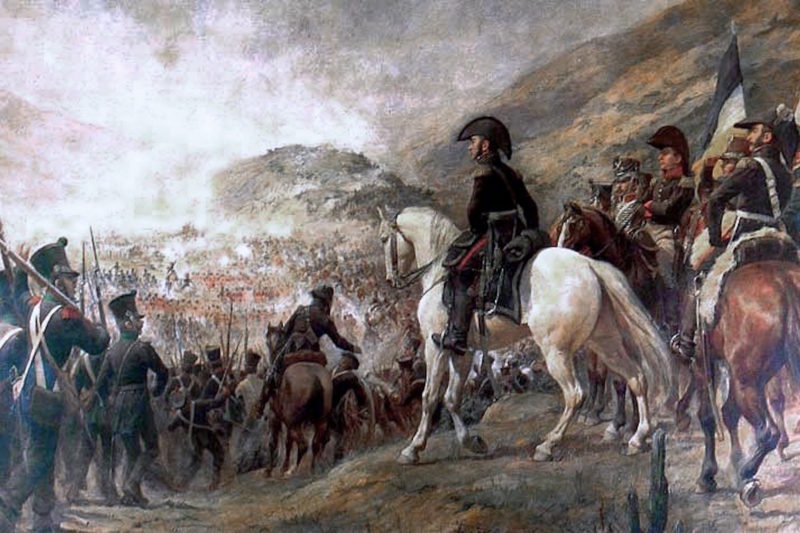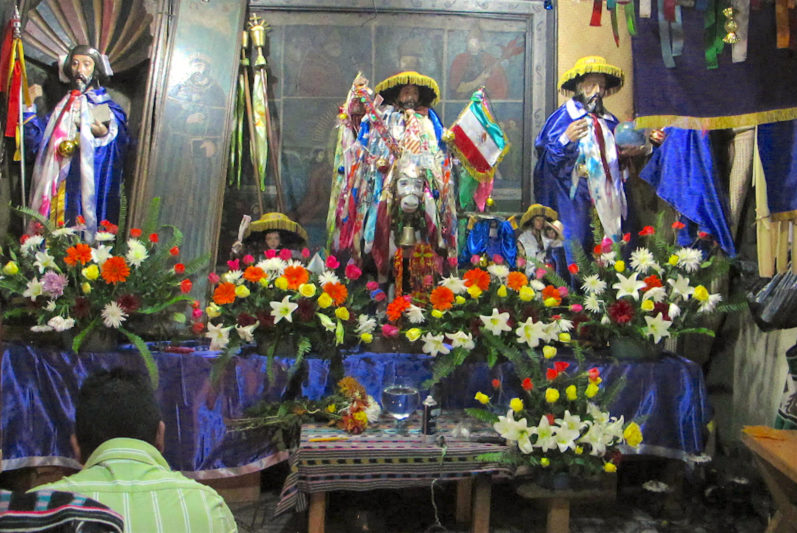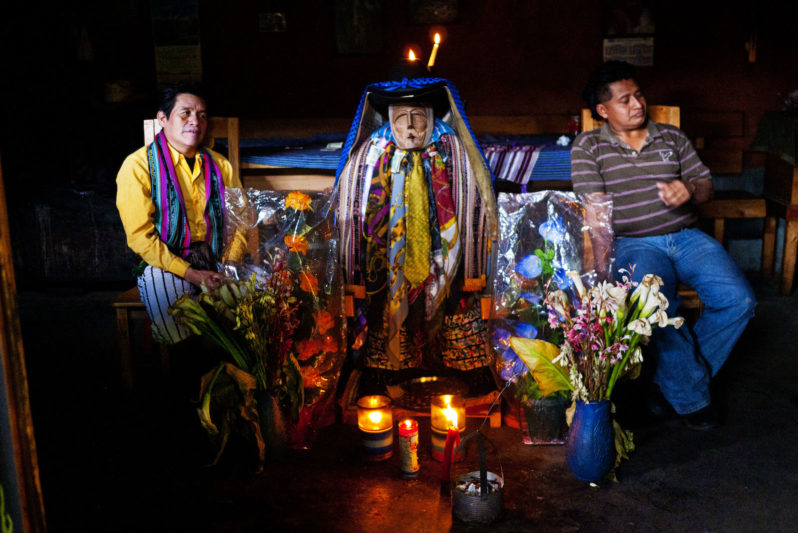 Wild and wonderful Santiago is one of the most traditional Mayan towns on Lake Atitlan. The original name of this Tzu’tujil (Tzoo- tu-hil) Mayan town is Tz’Kin Jay, House of the Birds. And like the birds that sing raucously here and adorn local women’s huipiles and men’s skaf (traditional tops and pants), Santiago is alive with color, sound, and a vibrant community.
Wild and wonderful Santiago is one of the most traditional Mayan towns on Lake Atitlan. The original name of this Tzu’tujil (Tzoo- tu-hil) Mayan town is Tz’Kin Jay, House of the Birds. And like the birds that sing raucously here and adorn local women’s huipiles and men’s skaf (traditional tops and pants), Santiago is alive with color, sound, and a vibrant community.
The densely packed in town is nestled tightly amidst the Lake’s shore and buttressed by the majestic Atitlan and Toliman volcanoes, known locally as Grandmother and Grandfather. The old ways of the Maya live here in tradition, ceremony, processions, fiestas, and the Cofradias.
For those visiting, there is not a lot written about the true depth of the vibrant traditionalist ways and ancient mystical yumminess that truly resides, largely hidden from the public eye. It’s true that most tour books and web info talk about the well-known and sometimes equally famous and infamous Tzu’tujil Mayan deity, Maximon. Yet, what most visitors don’t know is that his home is just one of eleven total Cofradias and two ancestral Ceremonial Houses throughout Santiago, Atitlan. These are the present day heart of Traditionalist Tzu’tujil Maya community, ritual, and an unbroken lineage of ancient Mayan ways.
What is a Cofradia?
Many books site the literal translation as ‘cofraternity’ or ‘brotherhood house’. In the Tzu’tujil language these are Armit Jay, Holy or Sacred Houses. The easiest translation for visitors is simply ‘ceremonial house’. To the community, they are the living, breathing, holy places where rituals and ceremonies of life and death are carried out each and every day. This is done by Shamans from here and others who come from afar, as well as the Cofradia members who serve and care for each altar and each house, just as it has been for hundreds of years.
During the time of the Spanish and Catholic Conquest in the 1500’s, the Catholic church placed these around the newly named town of Santiago, as a way of education and forced conversion of the local Maya to the newly arrived religion. Much debate, study, and academic wrangling has gone on over the past several decades as to whether these Holy Houses are indeed Catholic, Mayan, or some version of sacred syncretism. The answer to this is yes, no, and all of the above. What you see when you enter appears to be largely Catholic; the Saints, staffs, and images. Yet, the heart and origins of these are very much Mayan.
The Spanish Conquest of the Maya
In the early 1500’s the Catholic Friars and Spanish Conquistadores came to Guatemala. As they did throughout the Americas, they quickly began the forced relocation, conversion, and control of local Indigenous people. In Santiago this came early in the conquest, as noted by the completion date of the beautiful historic Santiago Apostal Catholic Church, in the year 1541. During this same era, the Cofradias were placed in homes and locations throughout town as a way of assimilation and education of the Tzu’tujil people. Many Cofradias exist in other areas, however, the local relationship and the function of these vary by community. Several have been lost over the centuries and decades, as other more fundamentalist Catholic and Evangelical influences have arrived. While some are revered in more Catholic context, others are richly Mayan.

The Umbilicus & The Ruins Left In Tact
It helps to also understand that the Catholic Church here is known to traditionalists as the Umbilicus, Rum’xux . It is one of the sacred cardinal points that orient this town and is built on top of an ancient holy Maya ritual site. This was common conquest practice; placing your holy place on top of the holy of that which you’re there to conquer. The same happened in many other towns, too.
Strangely, the Maya King of the time, Rey Tepepul, and the ruling spiritual center of Chiutinamit (across the bay) were left in tact. This was very rare because allowing the heart of the Maya ways and wisdoms to remain in place was not a common practice of conquest.
The Catholic Friars and Conquistadores only stayed here for about 100 years before departing for more fruitful pillaging and conversion elsewhere. After their departure, a Priest from Solola (the Department Capitol across the lake) would come once a month to give Mass. This remained the practice until the mid-twentieth century so, the impact was comparatively limited.
Surviving Catholic Influence
Even during the presence of Catholic influence, the amalgamation of faiths and divinity continued to live intact, with its original Maya roots firmly in place, seeding and growing over the millennia. To this day, the Tzu’tujil people still have an amazing resilience and craftiness that most outsiders can’t see or understand. Much of this comes from the Maya worldview that life lives in constant cycles of regeneration – death, rebirth, and the renewal of the world. It’s accepted fact that change will come and when it does, you engage it; albeit in often trickster ways as you’ll see in a bit.
This change had been a prophecy, an advisement given by the living Nawals (ancient wise leaders) to the people, just like the famous 2012 prophecies. These wise shamans, astrologers, midwives, and elders foresaw foreigners arriving on their land and changing the world as they knew it. This was the Post Classical Maya equivalent to 2012. It was the previous Baktun, or cycle of 500+ years in the Mayan Calendar.
Thus, they had planned for it. They had done their rituals and ceremonies and advised the people. Just as the 2012 prophecies advised from centuries before, that this present time of change, this current Baktun we live in, would be one in which the world and people would be called to remember the sacred as central to life, or they would destroy life.
Honoring Old Tradition
At the time of the Conquest, the Tzu’tujil people learned and asked what the nature of these new Saints were and found the equivalence in their own. For example, as Umbilicus was built, the images of Saints (Nawals to the Maya as they are deities in this regard) you still see today were being formed, and the people here created them in their old ways. This meant they secretly and often subversively did as they were told, but created it through ancient rituals, consecrations, and literal burying of medicine secrets within everything. The outer images changed, but the heart, the seeds, and the sacred roots of the Tzu’tujil traditions of thousands of years remained planted and growing as it always had. This is the wisdom way and regenerating nature of a sacred trickster.
Maximon
Now back to Maximon, who is also a sacred trickster in his own right, was formed during this same historical time period. The ancient Nawals birthed and created him to serve as Great Grandfather, who would take care of his Grandchildren for centuries and cycles of time to come, long after these wise one’s had passed on to the spirit world. Most state he was formed sometime during the 1400’s, prior to the Conquest. This was part of the preparation for the coming of the Spanish; the change.
Maximon is a more modern name that most agree comes from the original world Maxmuen, meaning bundled or tied one. This is much like the holiness that many know more commonly as medicine bundles in indigenous traditions throughout the globe. To traditionalists he is Mam or Rilaj Mam, Great Grandfather or Wise Venerable One.
In simple terms, Mam and Christ reside together in the Cofradia Santa Cruz as one from the old and one from the new; Grandfather’s work held in the physical and MaNawal’s work that of the inframundo, or spiritual world. This living relationship is the same twin nature of the original Hero Twins in the Popol Vuh, one of the few surviving texts of Maya Creation from the time prior to the Conquest.
Over these centuries and into the present day, the Cofradias of Santiago Atitlan form a sacred network, a web of holy places in which all aspects of life are cared for. In the old ways, these form the literal body, blood, heart, limbs, brain, and veins of life lived here on the belly of Mother Earth. They are a living and breathing reality – just like we are as human beings. All of this is watched over by Father Sun who lights our footpath each day as we walk on the belly and body of Mother Earth. And each night, life is given birth to, over and over again, with each dawning and dusking day by the great midwife, Grandmother Moon.
Finding The Connection
These altars of ancient wise Nawals – guides, experts, creators, and caretakers of all people – that live in the Cofradias are the relatable equivalent to our modern day lawyers, doctors, holy one’s, accountants, astrologers, scientists, teachers, and experts of all kinds. They are equally alive and expert.
This is why they live in people’s homes and are cared for as the living ancestors that they are in the Cofradias. They are fed and cleansed. Their clothes are changed, their community ceremonies are carried out, and their daily offerings are made. Just as you would lovingly and sacredly care for your parent or grandparent in your home, they are also our living grandparents and we are their grandchildren. The seeded one’s from that original maize tree of life of the original Maya, who live in this present season of life.
The lineage is lived in the knowing that countless others have come and cared for them before us. And we pray that countless others will do the same when we return to the world of spirit as these Baktun cycles of time continue. It’s all just caring for life, knowing death will come and life will sprout again. This is the Tzu’tujil worldview and way of living.
So, whether you come to visit Mam or explore deeper to encounter some of the other sacred Ceremonial Houses here in Tz’kin Jay, also know that coming is also a part of this prophecy.
A Translation Of An Ancient Prophecy
As told to me by the elders:
One day people of all colors of the sacred corn—red, white, yellow and brown (black)—will come to our land. And when they come, they will arrive on big birds and flying boats. They will come from many lands. When this day is upon us, it will be a time of great change once again and the world will need to remember the Old Ways.
This will be a time when all colors of the corn will be called to come together as one Tree of Life. It will be at a time when our own youth will have begun to forget the sacred ways. The people of these other lands will come because they will have forgotten, too. They will come to remember and to receive the ancient wisdoms.
When this time and these people come, you are to receive them and teach them. Those who come will have been called by the spirits. What we have cared for and sustained of the ancient sacred ways of our ancestors will again be needed, for the world will be out of balance and in pain. It is in this way that we will all come together as one Tree of Life, reborn of all colors of the corn. In our joining and our remembering we will find balance once again.
Conclusion
The Traditionalist Maya ways have their struggles. Many of the more ancient ways are shrinking and have disappeared in recent decades. The influences of modernization, fundamentalist religions, and the desires of people for change have dwindled our numbers. Yet, it is indeed alive here and the seeded and seeding one’s are still tending this ancient holy garden.

